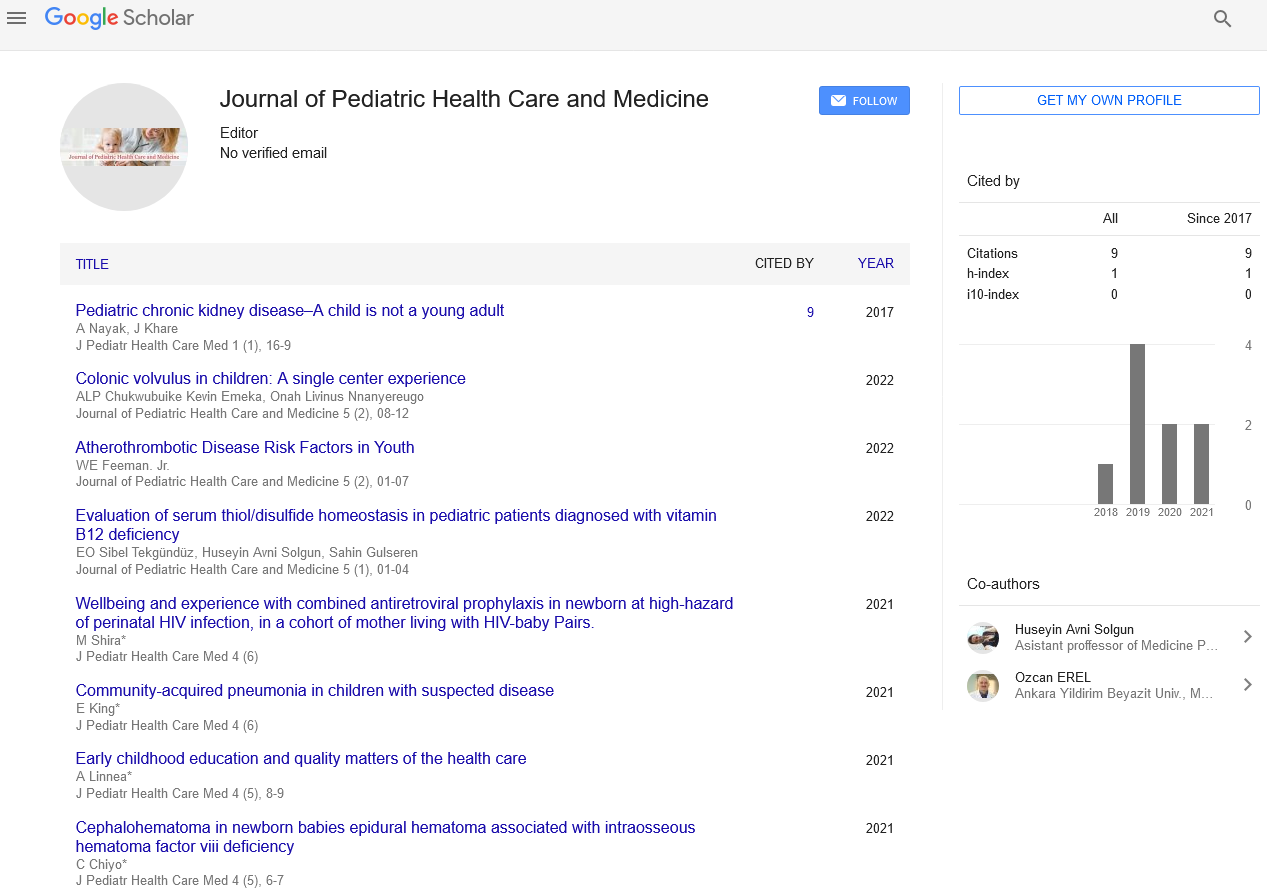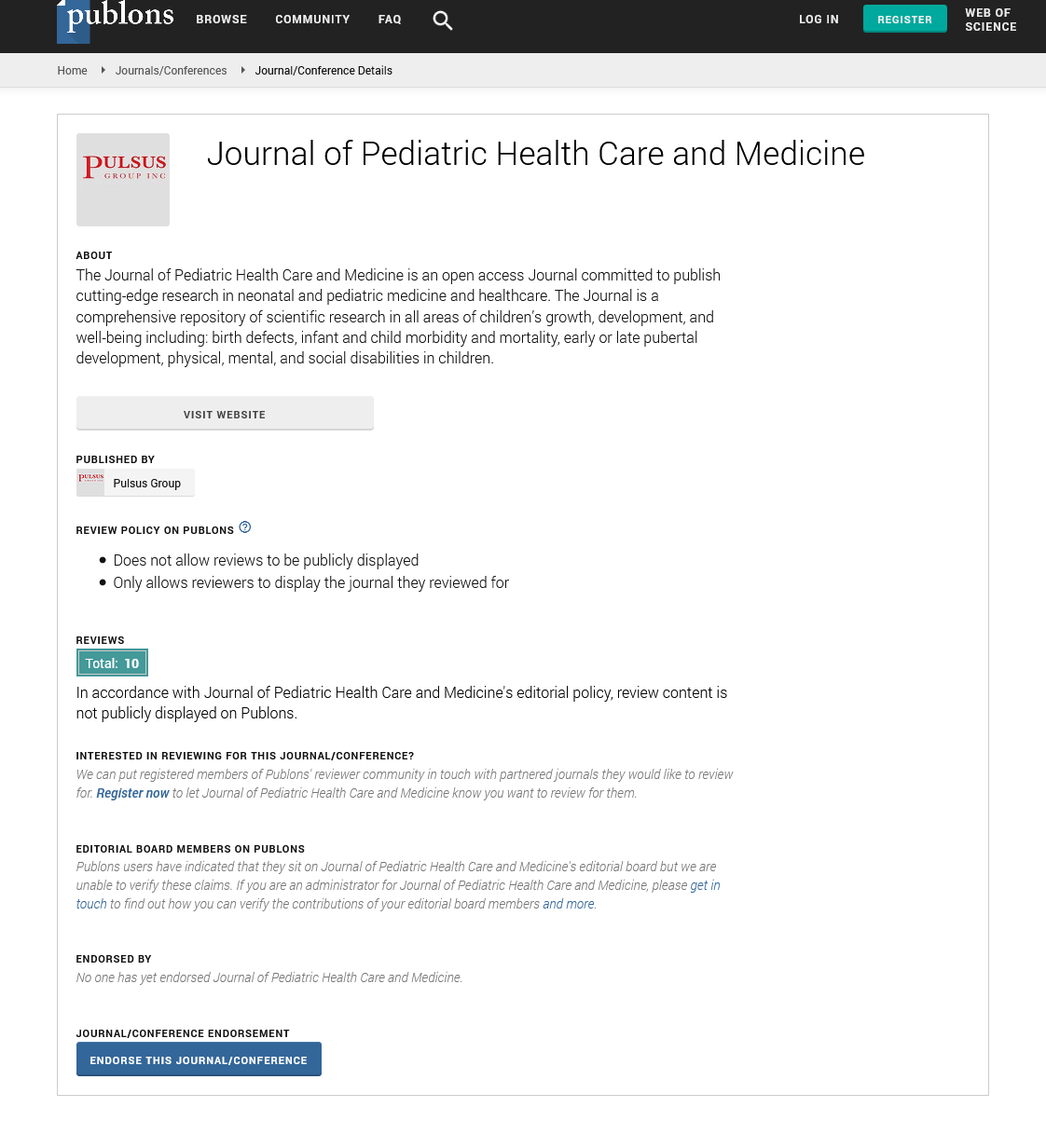Neonatal abstinence syndrome
Received: 04-May-2022, Manuscript No. puljphcm-22-4985; Editor assigned: 07-May-2022, Pre QC No. puljphcm-22-4985 (PQ); Accepted Date: May 26, 2022; Reviewed: 17-May-2022 QC No. puljphcm-22-4985 (Q); Revised: 23-May-2022, Manuscript No. puljphcm-22-4985 (R); Published: 28-May-2022, DOI: 10.37532/puljphcm.2022.5 (3).38-39
Citation: Wruble A. Neonatal abstinence syndrome. J Pedia Health Care Med. 2022; 5(3):38-39.
This open-access article is distributed under the terms of the Creative Commons Attribution Non-Commercial License (CC BY-NC) (http://creativecommons.org/licenses/by-nc/4.0/), which permits reuse, distribution and reproduction of the article, provided that the original work is properly cited and the reuse is restricted to noncommercial purposes. For commercial reuse, contact reprints@pulsus.com
Abstract
The onset and severity of Neonatal Abstinence Syndrome (NAS) in newborns exposed to prenatal opioids have shown significant variation. Because maternal opioid dosage does not appear to be linked to neonatal outcome, maternal, placental, and fetal genetic variations might have a role in NAS. Previous small cohort studies have linked variations in maternal and baby genes encoding the -Opioid Receptor (OPRM1), Catechol-O-methyltransferase (COMT), and Prepronociceptin (PNOC) to a shorter hospital stay and a lower requirement for therapy in newborns exposed to opioids in utero. The unbiased discovery of genomic variants and gene pathways associated with differences in maternal and fetal opioid pharmacokinetics and pharmacodynamics, as well as placental opioid transport and metabolism, will be enabled by falling genomic sequencing costs and computational approaches to predict variant function. The identification of pathogenic variations should allow for a more accurate assessment of the risk of acquiring more severe types of NAS. This study summarizes the existing involvement of genetic variables in the development of NAS and offers future genomic research initiatives.
Keywords
Neonatal abstinence syndrome; Receptors; Hospitalizations; Drugs
Introduction
Due to large increases in prenatal opioid exposure, there is presently an epidemic of Neonatal Abstinence Syndrome (NAS). The prevalence and severity of NAS in newborns exposed to prenatal opioids have shown significant variation. The promise of precision medicine has sparked a surge of interest in finding genetic variations that might help anticipate the onset and severity of NAS, as well as suggest new therapeutic methods for both prevention and therapy. Because of the frequent requirement for longer hospitalizations and the higher likelihood of unfavorable long-term newborn neurodevelopmental outcomes, the economic, emotional, and societal costs of NAS are significant. While most newborns with NAS react well to opioid treatment, a small percentage of those who are exposed will require extra pharmacological therapy (e.g., phenobarbital, clonidine) and prolonged hospital stays. Multiple environmental variables influence neonatal outcome, including maternal socioeconomic status and prenatal exposure to various illegal and prescribed drugs. Because of prior connections between specific genetic variations and outcome, low predictive accuracy of most clinical and demographic parameters, and rapidly dropping sequencing costs, precision medicine approaches including genomic-based prediction of NAS severity are particularly appealing. Epigenetic modulation of genes involved in maternal and fetal drug metabolism, as well as placental drug metabolism and transport, has been linked to illness severity in the past.
Genomic Variants Associated with NAS Risk and Severity
Opioid addiction is heritable, according to twin studies. Because of this heritability, case-control studies have looked at the relationship between several Single-Nucleotide Polymorphisms (SNPs) in genes involved in opioid metabolism and addiction and length of hospitalization, pharmacologic treatment need, and total days of opioid treatment in neonates with NAS. The findings imply that SNPs in both the mother and the child are linked to the severity of NAS. SNPs in maternal and baby genes that encode the -Opioid Receptor (OPRM1), Catechol-O-methyltransferase (COMT), and Prepronociceptin (PNOC) were linked to disparities in neonatal outcomes in investigations of opioid-exposed newborn infants and their mothers (length of hospitalization and reduced need for treatment with two medications).
Furthermore, variations in allele frequencies imply that using a small number of SNPs as disease biomarkers will necessitate race/ethnicity-based classification and admixture evaluation. Improved risk evaluation of specific SNPs and comparison of the contributions of maternal and infant drug metabolism to NAS risk may be possible using functional annotation and prediction tools. Finally, due to the intricacy of the genomic architecture, developmental control of gene expression, and the contributions of maternal drugs and complicating diagnoses, SNP-based techniques will require additional refining before being employed therapeutically.
NAS Genomics Research Future Directions
Extending existing SNP-based investigations of NAS genomics may benefit from utilizing big, varied exome and genome databases to investigate the expected function and frequency of both common and unusual SNPs in genes known to be linked with heritable addiction or drug metabolism changes. Falling sequencing costs will enable the finding of therapeutically actionable genetic variations in individual mother/infant dyads. This method should eliminate the requirement for linkage disequilibrium or imputation. Unbiased whole exome or genome sequencing would allow researchers to assess the impact of uncommon variations in both known and unknown genes to NAS severity. The statistical hurdles associated with rare variant detection can be mitigated in part by employing a family study design (e.g., twin studies) to limit the contributions of very heterogeneous genetic backgrounds to phenotype and the various confounding co-variables present in case-control studies. Examining babies with severe NAS may potentially boost statistical power to find important genetic variations. A search of copy number and structural variation databases for people who are haploinsufficient for certain genes might potentially provide an approach for assessing the functional impact of loss of function alleles. Standard phenotyping that includes predictions of functional influence on opioid metabolism, as recommended for the cytochrome P450 genes, as well as currently accepted measures of NAS severity, may also be informative.
Model systems for investigating the gestational age-specific impacts of individual variations will most likely be required for developmental control of important drug-metabolizing and placental transport genes. Finally, it will be necessary to develop statistical methodologies that account for confounding variables like as breastfeeding, smoking, and the use of protocol-driven drug weaning procedures in order to assess the contributions of genetic variations to these types of clinical characteristics. Precision medicine applied to the problem of NAS might assist the numerous people and neonates who have been exposed to opioids by offering personalized risk prediction and leveraging the finding of candidate genes for the development of innovative treatment techniques.
These are some of the possible advantages of a more precision medicine-guided approach, which might be implemented with the rapid development of new genomics technologies. What matters most is adequate financing, and legislative actions are presently pushing this innovation and providing a road ahead to address NAS in this particularly vulnerable group.






